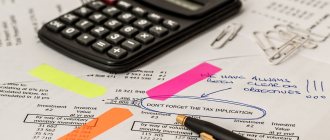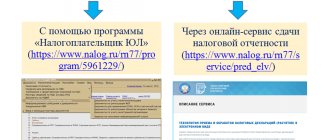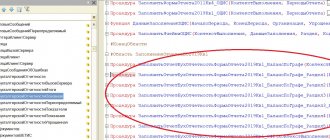What is a balance sheet and how to draw it up using a sample form? What form does the LLC's balance sheet have and what items does it contain? What are the stages of analyzing a company's balance sheet?
Dear friends, I, Alla Prosyukova, welcome you to the pages of the HeatherBober online magazine!
I suggest you read a new article about the procedure for drawing up the balance sheet of an enterprise.
I tried to explain the procedure for compiling a balance sheet as simply and clearly as possible using practical examples.
What is a balance sheet and why is it prepared?
Most Russian companies compile and present various accounting reports.
The main set of such reporting includes five forms:
- Form No. 1 - “Balance Sheet;
- Form No. 2 - “Report on financial results”;
- Form No. 3 - “Report on changes in capital”;
- Form No. 4 - “Cash Flow Statement”;
- Form No. 5 - “Appendix to the Balance Sheet”.
I propose to take a closer look at form No. 1 – balance sheet.
The balance sheet is information about the company’s property (assets) and the sources of its acquisition (liabilities), grouped as of the reporting date in the form of a table. An asset is always equal to a liability!
Let's get acquainted with the principles of drawing up a balance using the example of the budget of one Russian family.
Example
A large, friendly Pugovkin family lives in the city of N. The family is wealthy by city standards. They have: an apartment, a car, household appliances, furniture, clothes, food, a summer house. In addition, there is money in the wallets and bank accounts of family members.
In general, the Pugovkins have everything they need for a comfortable active life. These will be the assets of the Pugovkin family.
Take a sheet of blank paper and write all of the above in 2 columns.
Assets of the Pugovkin family:
| Article | Name | Cost, thousand rubles |
| 1 | Apartment | 4 000 |
| 2 | Country house | 1 000 |
| 3 | Car | 1 100 |
| 4 | Appliances | 300 |
| 5 | Products | 50 |
| 6 | Money in wallets | 30 |
| 7 | Money in the bank | 450 |
| 8 | Furniture | 610 |
| 9 | Cloth | 40 |
| 10 | Total | 7 580 |
To acquire all this, the family needed funds. Therefore, the Pugovkins took out a bank loan and borrowed part of the money from friends. In addition, the Pugovkin family currently has unpaid utilities and property taxes.
A bank loan, debt to friends, unpaid utility bills and taxes are the liabilities of the Pugovkin family.
Liabilities of the Pugovkin family:
| № | Name of liability | Cost, thousand rubles. |
| 1 | Bank loan | 6 184 |
| 2 | Debt to friends | 1 200 |
| 3 | Debt to utilities | 11 |
| 4 | Tax debt | 25 |
| 5 | Salary of family members | 160 |
| 6 | Total | 7 580 |
The assets and liabilities of the balance sheet are divided into several parts.
Asset sections:
- non-current assets;
- working capital.
Passive sections:
- capital and reserves;
- long term duties;
- Short-term liabilities.
The balance sheet is in demand by various users.
External users:
- tax authorities;
- banks;
- investors;
- partners (counterparties).
Internal users:
- shareholders of the company;
- planning and analytical department.
Features of preparing financial statements for individual entrepreneurs and LLCs
The peculiarity of drawing up a BO by an individual entrepreneur is that its content and volume depend on:
- number of employees;
- tax regime.
In the case when an individual entrepreneur works for the simplified tax system, he does not have to do accounting at all. This means that he does not constitute a BO.
LLCs that also use the simplified tax system have the right to simplified methods of accounting and preparation of financial statements. The forms of reporting documents are approved by Ministry of Finance orders. And although they are less voluminous than for enterprises on OSNO, you need to fill out both a balance sheet and reports on financial results and the intended use of funds.
All other organizations must keep accounting records and prepare financial statements in full. The reports are signed by the individual entrepreneur, the signature must be deciphered and the date when exactly the document was drawn up is indicated. Even if the balance sheet is filled out in a simplified form, the equilibrium rule continues to apply - the amounts for assets and liabilities are absolutely identical.
Important! When an individual entrepreneur begins to develop a business, he invests his own or borrowed funds into it. A correctly drawn up balance sheet, even in a simplified form, will present a complete picture of where they were used and what the financial condition is now.
How to draw up a balance sheet - step-by-step instructions for beginners
The process of preparing a balance sheet is very complicated, not only for beginners. Some aspects of its preparation may cause difficulties for professional accountants.
I propose to consider with me step by step its main points.
Step 1. Specify the details
As a rule, filling out any reporting form begins with the title page. The balance sheet is no exception. To fill it out, a unified form approved by the Ministry of Finance is used.
The first sheet contains the details of the company making up the balance sheet:
- the date on which the form is drawn up;
- Date of preparation;
- Company name;
- an identification number;
- type of economic activity;
- type of ownership;
- unit of measurement;
- location of the company.
Step 2. Fill in the rows of the asset table
The next step is to fill out the asset balance sheet. We take all the information from the balances of the company’s accounts (we use the balance sheet (SAS)).
Example
For Pomidorka LLC, 2021 is the first period when the company needs to report, because it was in this year that the company was created. Let's present the balances according to accounting data in the form of a table.
Balances of Pomidorka LLC as of 01/01/2017:
| № | Name | Check | Debit | Credit |
| 1 | Fixed Assets (Fixed Assets) | 01 | 500 | |
| 2 | Depreciation of fixed assets | 02 | 26 | |
| 3 | Intangible assets (IMA) | 04 | 100 | |
| 4 | Depreciation of intangible assets | 05 | 4 | |
| 5 | Reserves | 10 | 460 | |
| 6 | VAT | 19 | 16 | |
| 7 | Money in the cash register | 50 | 40 | |
| 8 | Funds in bank account | 51 | 120 | |
| 9 | Authorized capital | 80 | 30 | |
| 10 | Reserve capital | 82 | 10 | |
| 11 | retained earnings | 84 | 150 | |
| 12 | Settlements with suppliers and contractors | 60 | 275 | |
| 13 | Settlements with buyers and customers | 62 | 85 | |
| 14 | Calculations for long-term loans and borrowings | 67 | 300 | |
| 15 | Calculations for taxes and fees | 68 | 16 | |
| 16 | Social insurance calculations | 69 | 90 | |
| 17 | Payroll calculations | 70 | 250 | |
| 18 | Total | 1236 | 1236 |
When drawing up a balance sheet, remember that:
- debit and credit balances in the balance sheet are not collapsed;
- Fixed assets and intangible assets are shown at residual value;
- assets in the balance sheet are reflected at book value.
Information in the balance sheet is divided item by item (approved by the Ministry of Finance). Opposite each item is the amount taken from the SALT on the reporting date; in 2 adjacent columns the itemized value of the property for the two previous reporting dates is indicated.
Continuation of the example
Based on the accounting data of Pomidorka LLC, we will compile a part of the balance sheet called “Asset”.
Active:
| Index | Calculation | Code | as of 12/31/2016 | as of 12/31/2015 |
| ASSETS | ||||
| I. Non-current assets | ||||
| NMA | sch04-05 | 1110 | 96 | — |
| OS | sch01-02 | 1150 | 474 | — |
| Summary of Section I | 1110+1150 | 1100 | 570 | — |
| II. Current assets | ||||
| Reserves | sch10 | 1210 | 460 | — |
| VAT on purchased material assets | sch19 | 1220 | 16 | — |
| Cash and cash equivalents | sch50+51 | 1250 | 160 | — |
| Summary of Section II | 1210+1220+1250 | 1200 | 636 | |
| BALANCE | 1100+1200 | 1600 | 1206 | |
Information is indicated in whole thousands or millions of rubles. Blank rows are not included in the table. In a real balance sheet, all lines must be present; they are simply marked with a dash.
Step 3. Fill in the rows of the liability table
We do the same when filling out the “Passive” section. Let's take a closer look at the example of Pomidorka LLC.
Example
Filling out the “Passive” section:
| Index | Calculation | Code | as of 12/31/2016 | as of 12/31/2015 |
| PASSIVE | ||||
| III. Capital and reserves | ||||
| Authorized capital | count 80 | 1310 | 30 | — |
| Reserve capital | count 82 | 1360 | 10 | — |
| retained earnings | count 84 | 1370 | 150 | — |
| Summary of Section III | 1310+1360+1370 | 1300 | 190 | |
| IV. long term duties | ||||
| Borrowed funds | count 67 | 1410 | 300 | — |
| Summary of Section IV | 1410 | 1400 | 300 | — |
| V. Current liabilities | ||||
| Accounts payable | count 60+62+68+69+70 | 1520 | 716 | — |
| Summary of Section V | 1520 | 1500 | 716 | — |
| BALANCE | 1300+1400+1500 | 1700 | 1206 | — |
Step 4. Compare table values
Do you remember that asset = liability? In the balance sheet, line 1600 and line 1700 have the same figure of 1206 thousand rubles. This indicates that the form is drawn up correctly.
If there are discrepancies in these lines, it means that an error has crept into the accounting, which must be found.
Let me tell you right away, this is not an easy task. First, I recommend checking the arithmetic calculations. If there are no problems with arithmetic, proceed to checking the accounting entries in OSV.
Step 5. We analyze the balance sheet according to its indicators
Analysis of the balance sheet and its indicators is a complex, multi-stage process. I told you how to do it above. The results of the analysis help optimize the financial policy of the company. A high-quality analysis allows you to make competent management decisions.
How to make a balance sheet?
Drawing up a balance sheet is the final stage of accounting work.
And it can be compiled correctly only on the basis of complete and reliable data contained in the accounting system. Such data is collected in accounting registers. The data from these registers and their transcripts are the information base for reporting, incl. and balance sheet. When preparing a balance sheet, it is important not only to know the procedure for maintaining accounting records and reflecting transactions in accounts, but also to remember the basic rules specific to the preparation of financial statements.
For example, in the balance sheet, assets and liabilities should be divided into short-term and long-term (clause 19 of PBU 4/99). Assets and liabilities are considered short-term if their circulation (repayment) period does not exceed 12 months after the reporting date or the operating cycle if it is more than 12 months. And all other assets and liabilities are presented on the balance sheet as long-term. That is why fixed assets are reflected in the balance sheet in section I “Non-current assets”, and goods - in section II “Current assets”.
Who provides balance sheet services - review of the TOP 3 companies
Accounting services, including services for preparing balance sheets, are offered by many companies.
By tradition, I have prepared for you, my readers, a selection of reliable, highly professional accounting firms.
1) My business
Internet accounting “My Business”, despite its young age (founded in 2009), has earned well-deserved respect from more than 50,000 users in all Russian regions.
Users note a number of advantages that they have and which predetermined the choice of this company.
Advantages of online accounting “My Business”:
- affordable prices (subscription fee from 366 to 2083 rubles per month);
- friendly, fast and professional support;
- wide range of services and opportunities;
- clear educational materials that can turn a beginner into a professional;
- the ability to register your business online;
- a large database of ready-made document templates for most business processes;
- accountant's bureau, consisting of 17 sections with answers to more than 10 thousand user questions.
If you are still hesitating, then visit the “My Business” website, read reviews from real users, and learn more about the functionality of this service.
A pleasant bonus for new users will be the opportunity to use online accounting services for free for a month.
2) Project-KM
The Moscow company Project-KM has been providing professional accounting services to legal entities, individual entrepreneurs and individuals for more than 9 years.
For the company's staff of highly qualified specialists, it will not be difficult to:
- formulate an Accounting Policy;
- organize accounting of any complexity;
- carry out full or partial restoration of accounting;
- carry out tax accounting;
- organize effective management accounting.
A potential client can receive an initial consultation by visiting the Project-KM office, calling the company, or consulting online on the website.
In addition, on the Project-KM website you can fill out an online form for a preliminary calculation of the cost of services, order services and pay for them.
3) Abacus BC
Abak BC is an accounting company that employs professional accountants with more than 16 years of experience. The company has successfully passed more than 500 tax audits.
Company Services:
- calculation of financial results, taxes and fees of the customer’s company;
- conducting banking and cash transactions;
- preparation and submission of reports;
- personnel records management and organization of settlements with personnel.
Abak BC clients receive a number of benefits from cooperation:
- savings on paying for a full-time accountant;
- 24-hour consulting professional support;
- complete confidentiality.
If you transfer the accounting of your company to the specialists of Abak BK, the savings on accounting costs will be about 32%. This result is achieved due to the fact that the customer pays only for the work actually performed.







